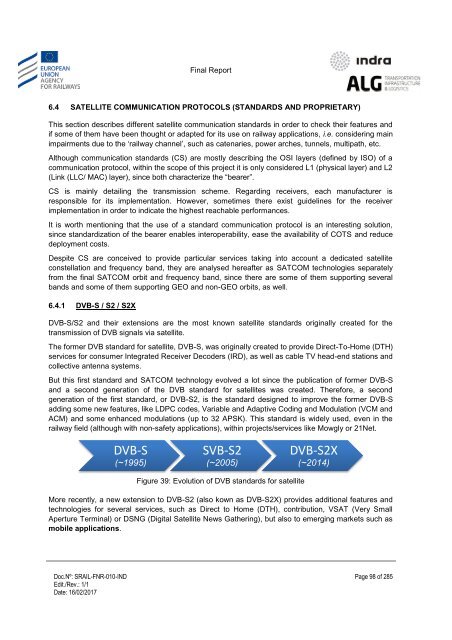Study on feasibility of SATCOM for railway communication
SRAIL-FNR-010-IND%20-%20FinalReport_v1.1_20170216
SRAIL-FNR-010-IND%20-%20FinalReport_v1.1_20170216
You also want an ePaper? Increase the reach of your titles
YUMPU automatically turns print PDFs into web optimized ePapers that Google loves.
Final Report<br />
6.4 SATELLITE COMMUNICATION PROTOCOLS (STANDARDS AND PROPRIETARY)<br />
This secti<strong>on</strong> describes different satellite communicati<strong>on</strong> standards in order to check their features and<br />
if some <strong>of</strong> them have been thought or adapted <strong>for</strong> its use <strong>on</strong> <strong>railway</strong> applicati<strong>on</strong>s, i.e. c<strong>on</strong>sidering main<br />
impairments due to the ‗<strong>railway</strong> channel‘, such as catenaries, power arches, tunnels, multipath, etc.<br />
Although communicati<strong>on</strong> standards (CS) are mostly describing the OSI layers (defined by ISO) <strong>of</strong> a<br />
communicati<strong>on</strong> protocol, within the scope <strong>of</strong> this project it is <strong>on</strong>ly c<strong>on</strong>sidered L1 (physical layer) and L2<br />
(Link (LLC/ MAC) layer), since both characterize the ―bearer‖.<br />
CS is mainly detailing the transmissi<strong>on</strong> scheme. Regarding receivers, each manufacturer is<br />
resp<strong>on</strong>sible <strong>for</strong> its implementati<strong>on</strong>. However, sometimes there exist guidelines <strong>for</strong> the receiver<br />
implementati<strong>on</strong> in order to indicate the highest reachable per<strong>for</strong>mances.<br />
It is worth menti<strong>on</strong>ing that the use <strong>of</strong> a standard communicati<strong>on</strong> protocol is an interesting soluti<strong>on</strong>,<br />
since standardizati<strong>on</strong> <strong>of</strong> the bearer enables interoperability, ease the availability <strong>of</strong> COTS and reduce<br />
deployment costs.<br />
Despite CS are c<strong>on</strong>ceived to provide particular services taking into account a dedicated satellite<br />
c<strong>on</strong>stellati<strong>on</strong> and frequency band, they are analysed hereafter as <strong>SATCOM</strong> technologies separately<br />
from the final <strong>SATCOM</strong> orbit and frequency band, since there are some <strong>of</strong> them supporting several<br />
bands and some <strong>of</strong> them supporting GEO and n<strong>on</strong>-GEO orbits, as well.<br />
6.4.1 DVB-S / S2 / S2X<br />
DVB-S/S2 and their extensi<strong>on</strong>s are the most known satellite standards originally created <strong>for</strong> the<br />
transmissi<strong>on</strong> <strong>of</strong> DVB signals via satellite.<br />
The <strong>for</strong>mer DVB standard <strong>for</strong> satellite, DVB-S, was originally created to provide Direct-To-Home (DTH)<br />
services <strong>for</strong> c<strong>on</strong>sumer Integrated Receiver Decoders (IRD), as well as cable TV head-end stati<strong>on</strong>s and<br />
collective antenna systems.<br />
But this first standard and <strong>SATCOM</strong> technology evolved a lot since the publicati<strong>on</strong> <strong>of</strong> <strong>for</strong>mer DVB-S<br />
and a sec<strong>on</strong>d generati<strong>on</strong> <strong>of</strong> the DVB standard <strong>for</strong> satellites was created. There<strong>for</strong>e, a sec<strong>on</strong>d<br />
generati<strong>on</strong> <strong>of</strong> the first standard, or DVB-S2, is the standard designed to improve the <strong>for</strong>mer DVB-S<br />
adding some new features, like LDPC codes, Variable and Adaptive Coding and Modulati<strong>on</strong> (VCM and<br />
ACM) and some enhanced modulati<strong>on</strong>s (up to 32 APSK). This standard is widely used, even in the<br />
<strong>railway</strong> field (although with n<strong>on</strong>-safety applicati<strong>on</strong>s), within projects/services like Mowgly or 21Net.<br />
DVB-S<br />
(~1995)<br />
SVB-S2<br />
(~2005)<br />
DVB-S2X<br />
(~2014)<br />
Figure 39: Evoluti<strong>on</strong> <strong>of</strong> DVB standards <strong>for</strong> satellite<br />
More recently, a new extensi<strong>on</strong> to DVB-S2 (also kown as DVB-S2X) provides additi<strong>on</strong>al features and<br />
technologies <strong>for</strong> several services, such as Direct to Home (DTH), c<strong>on</strong>tributi<strong>on</strong>, VSAT (Very Small<br />
Aperture Terminal) or DSNG (Digital Satellite News Gathering), but also to emerging markets such as<br />
mobile applicati<strong>on</strong>s.<br />
Doc.Nº: SRAIL-FNR-010-IND<br />
Edit./Rev.: 1/1<br />
Date: 16/02/2017<br />
Page 98 <strong>of</strong> 285


